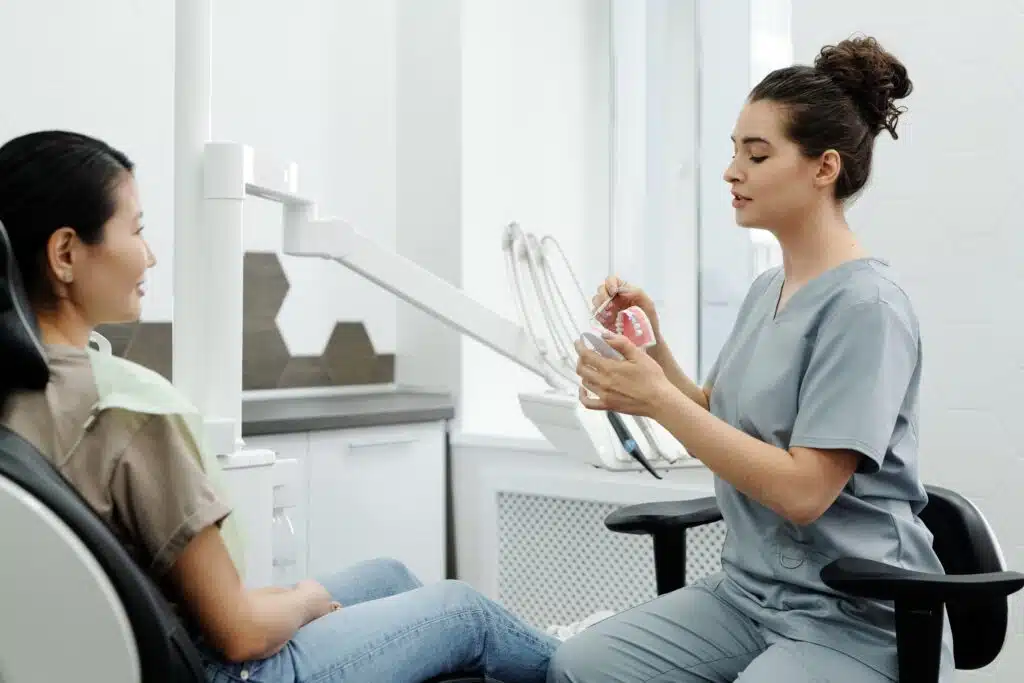One of the most complex joints in your body is also responsible for creating one of the most complex sets of painful symptoms you can experience. Unfortunately, there is much confusion about this condition and the acronym used to describe it. Continue reading to find out, what does TMD stand for, and help understand the causes and symptoms of TMD—or our emergency appointments for TMJ—a health problem that has increased recently due to COVID-19.
If you have any questions or concerns about jaw pain, schedule an appointment with Trident Dental for a comprehensive oral exam and TMJ evaluation.
What Are The Temporomandibular Joints?
Healthcare providers refer to the lower jaw as the mandible, which is the largest bone in your skull. The mandible is made of two parts, the body and the ramus. The body is the horizontal part of the mandible and holds your lower teeth. The ramus is the vertical part, and its upper-most part connects with the temporal bone of the maxilla, or upper jaw. This connection, or joint, lies on both sides of your face in front of your ears. Your dentist calls this the temporomandibular joint (TMJ).
What Are The Functions Of The TMJ?
In addition to the lower and upper jaw bones, the TMJ is composed of a fibrous disc that provides a cushion between these bones and prevents their touching. Several ligaments attach the bones at several locations, and a thick membrane or capsule surrounds the entire joint. This complex hinge-like joint works with four pairs of the jaw and facial muscles to allow various opening and closing jaw movements, including:
-
Speaking
-
Swallowing
-
Chewing
-
Yawning
What Is TMD?
You typically do not think about the temporomandibular joint until it creates a problem known as TMD (temporomandibular disorder). Most people call this painful condition TMJ instead of the more technically correct, TMD. Several conditions and factors can affect the temporomandibular joints, surrounding jaw muscles, and nerves that control your jaw movements. This can result in injury or misalignment of your TMJ and the painful temporomandibular disorder, which affects as many as 15% of Americans.
What Causes TMD?
It is often difficult to determine the cause of TMD. However, the possible causes include:
-
Bruxism (teeth grinding or clenching).
-
Arthritis.
-
Dislocation of the disc that cushions the joint.
-
Physical trauma from an accident.
-
Stress.
-
Upper and lower teeth that are not fitting together correctly.
What Are The Symptoms Of TMD?
Although the symptoms of TMD may involve a few days of mild pain, they can also cause severe and chronic pain that interferes with most aspects of everyday life. There are many possible symptoms, such as:
-
Pain or soreness in the jaw that may be worse in the morning.
-
Headaches.
-
Earaches.
-
Clicking or popping noises when opening your mouth.
-
Jaw locking open or closed.
-
Impaired ability to open or move your mouth.
-
Grinding your teeth.
-
Sensitive or painful teeth.
-
Teeth not biting properly.
-
Facial swelling.
-
Dizziness.
-
Pain or tightness in the neck or shoulders.
-
Pain in the sinuses or behind the eyes.
Schedule Appointment
Contact us at Trident Dental to learn how we can help you with any questions or problems you might experience with jaw pain or other possible symptoms of temporomandibular disorder. We offer various treatments to help alleviate your symptoms, including custom-made mouth and night guards.

